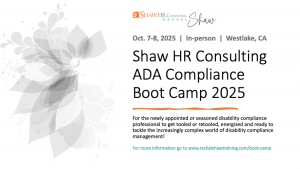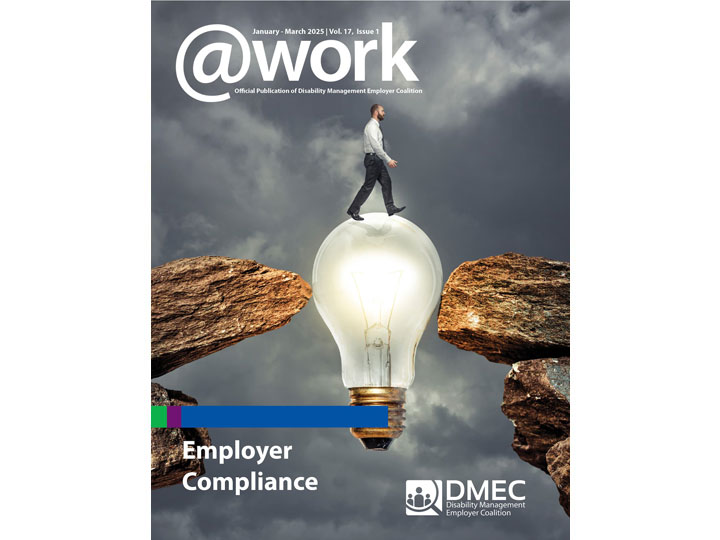Redefining Essential Functions to Ensure Compliance
By Rachel Shaw
@Work Magazine, January 2025
Employers are receiving more requests for accommodation, from “No heavy lifting” and “Can’t work with supervisor” to “Limited bending” and “No twisting.” How can an employer decide what is reasonable to accommodate?
When it comes time to meet with employees to determine if they can be accommodated, there is one definitive must-have: detailed and clear data. This includes functional limitations provided by a healthcare provider and a clear, accurate picture of the demands of a job, which are often captured in a job analysis or essential functions position analysis (EFPA).
Employers commonly work to obtain medical clarification on an employee’s functional limitation, but sometimes they cut corners and don’t document (in writing) a position’s essential job functions and how they are performed. Documentation is extremely helpful to the interactive process as it can turn what might feel like a subjective analysis of an employee’s abilities into an objective analysis between two key documents: a medical note and an EFPA.
An EFPA describes the traditional physical, mental, and emotional demands of any given job classification. It is not written for individuals but for an entire job classification. Employees may perform the job slightly differently than others in the job classification, but the work they do — the essential job functions — remains the same. Understanding how those essential job functions are traditionally performed is helpful to start and support an analysis of the reasonableness of any accommodation. For example, healthcare providers don’t comment on essential functions; they state limitations such as lifting, carrying, typing, or bending restrictions. Once these are clarified, an employer can review the job analysis or EFPA to see which essential functions are affected by the restricted activity. If the activity can be performed sufficiently to complete the essential function, then this is not an issue for the employee to continue to safely perform regular duty. However, if the activity restriction does not allow an essential function to be performed as it would be traditionally, the parties will discuss whether there are accommodations such as tools or methods to accomplish the essential function. For example, if a restriction calls for reduced bending, the employee might kneel instead of bend to do the low work, or even sit on a low chair or stool.
An EFPA is a collection of straightforward and accurate data, not a personal document. It represents functions everyone in that job classification traditionally performs. Using an EFPA as an established yardstick often helps employers and employees evaluate situations in a less emotional way because it isn’t personal to the employee seeking an accommodation. It helps evaluate the employee’s abilities or limitations against the reality of the job. Because the EFPA is developed for the job, it can be used for an Americans with Disabilities Act accommodation request, preemployment medical testing, and workers’ compensation claims.
An EFPA does not replace an existing job description. It complements the job description by answering questions that a job description typically does not include regarding how the essential functions in a position are performed. For example, exactly how much weight does a bus driver need to be able to push/pull to complete the essential function of wheelchair access support on a bus? Or how often, and for how long, would a plumber bend at the waist when installing new equipment?
The following chart shows an example of an EFPA section. The function numbers correlate to earlier pages in the document that list the specific essential job functions and how this specific physical activity is performed. This is important because healthcare providers rarely restrict essential functions. They offer or should be offering functional limitations such as lifting, carrying, pushing, or pulling:
Physical Activity
Performed |
Frequency |
Maximum Time Performed Before Break |
Occurs in Essential Function(s) |
Examples of How Activity is Performed |
| Upper Extremity/Arm Movement |
| Pushing
|
Occasional to frequent |
5 minutes repetitively |
1, 2, 3, 4, 5, 6, 7, 10 |
Special event setup/breakdown; moving custodial cart, trash cart, or hand truck/pallet jack; vacuuming; auto scrubbing; buffing; utilizing extractor wand; moving furniture; moving cleaning equipment; mopping; sweeping; using mop bucket; opening/closing drawers; opening/closing doors; using cart for delivery of supplies; sliding inventory into place on shelves; pushing trash cans/bags; loading/unloading supplies and equipment; painting field lines |
| Pulling
|
Occasional to frequent |
5 minutes repetitively
|
1, 2, 3, 4, 5, 6, 7, 10 |
Special event setup/breakdown; moving custodial cart, trash cart, or hand truck/pallet jack; vacuuming; auto scrubbing; buffing; utilizing extractor wand; moving furniture; moving cleaning equipment; mopping; sweeping; using mop bucket; opening/closing drawers; opening/closing doors; using cart for delivery of supplies; moving custodial cart, trash cart, or hand truck/pallet jack; sliding inventory into place on shelves; pulling trash cans/bags; loading/unloading supplies and equipment; painting field lines |
Lift/Carry Weight Requirements
Weight
Lifted/Carried (lb) |
Frequency |
Maximum Height
Lifted |
Distance Carried |
Occurs in Essential Function(s) |
Examples of How Activity is Performed |
| 1 to 10
|
Occasional to frequent |
Above shoulder |
200 yards
|
1, 2, 3, 4, 5, 6, 7, 8, 9, 11, 12 |
Cleaning supplies; small hand tools; trash; brooms; keys; two-way radio, cellphone, or tablet; chairs; spray bottles with solution; dust pans; classroom items; empty mop buckets; toilet paper and supplies broken out of a box; gallon of cleaner (8#); cleaning rags; mops and brooms; scraper; degumming solvent; power tools |
| 11 to 25
|
Occasional to frequent |
To shoulder |
30 yards |
1 2, 3, 4, 5, 6, 7
|
Mop buckets (25# partially filled); vacuum and other custodial equipment; trash bags and recyclables; smaller furniture; empty custodial cart (16#); backpack vacuum (17#); box of trash can liners (10#); box of folded paper towels (21#) |
| 26 to 50
|
Seldom to occasional |
To shoulder |
10 yards
|
1, 2, 3, 4, 5, 6, 7 |
Trash bags and recyclables; furniture; mop buckets; standard bottle of chemicals (individual 8#, case 32#); box of bath tissue (33#); box of toilet seat covers (27#); 12-foot ladder (35#); mop bucket with mop and half full of water (39#); buffer (40#); box of large trash can liners (49#); floor fan/dryer (32#); box of 12 paper towel rolls (42#); emptying water from cleaning equipment; full bankers boxes; 5-gallon water bottles; stage sections and risers; box of paper (48#); furniture; desks/chairs; full bags of trash; boxes of classroom supplies |
| 51 to 75
|
Never
|
N/A |
N/A |
N/A |
N/A |
| 76 plus
|
Never
|
N/A |
N/A |
N/A |
N/A |
An EFPA is a critical and often overlooked tool in the interactive process as it ensures that when comparing the employee’s limitations with the actual job requirements, employers use data of the work completed and observed, not a particular supervisor’s opinions or perceptions.
This approach depersonalizes the analysis of how restrictions will affect the job and allows parties to focus on data and trust the outcome more. It also protects the organization when employers use accurate data and not subjective opinions of any one party in the process.
Employers should always seek out and implement reasonable accommodations whenever possible. The goal is to make sure the accommodations resonate with the employer and employee. If a healthcare provider sends you suggested accommodations, such as “work from home,” ask for functional limitations so you can consider alternate accommodations. Healthcare providers are required to provide these specifics when they’re requested, and it is important for employers to make the request and obtain the information.
Having an objective employer document will help employers connect all of the dots and ensure reasonable accommodations are met. Employers can create these documents in-house or work with consultants to develop a bank of them for use as needed. The good news is that once these documents are created, they can be effective for a decade or more unless the work changes significantly.
DMEC-Related Resources








